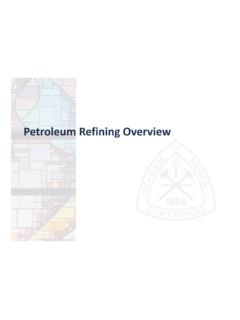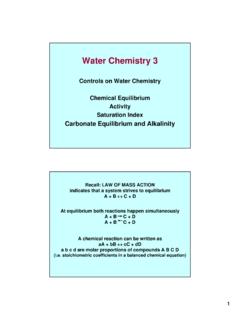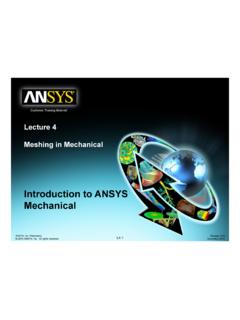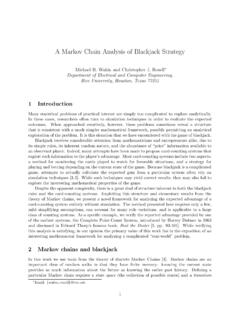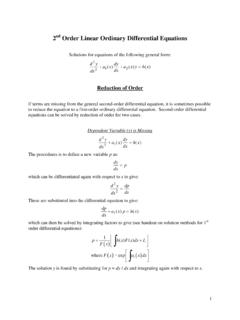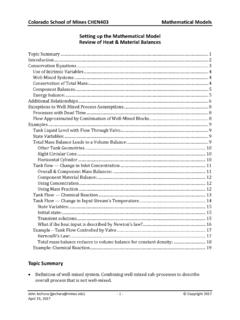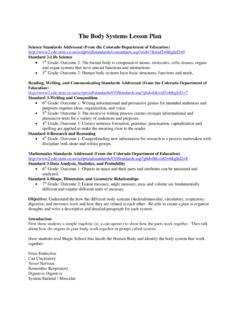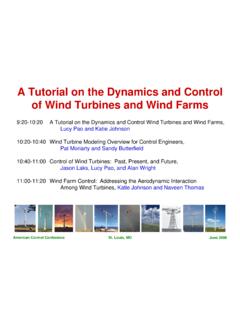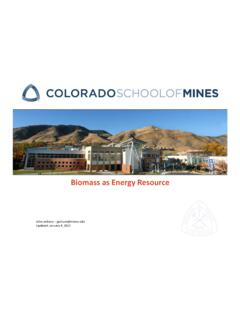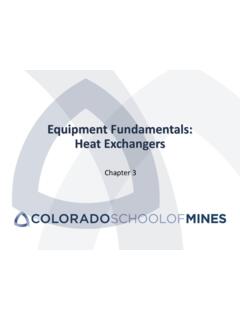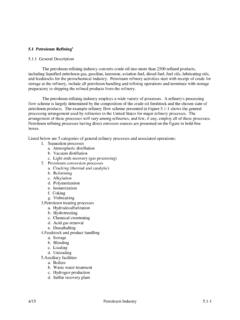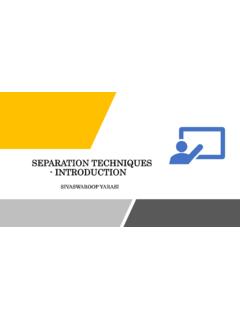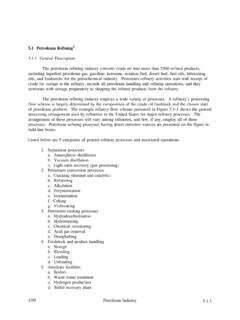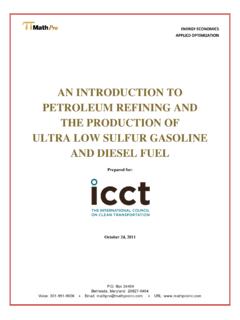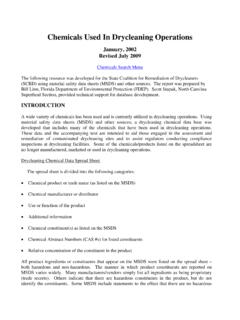Transcription of Tutorial: Delayed Coking Fundamentals - Campus Tour
1 1 Tutorial: Delayed Coking FundamentalsPaul J. EllisChristopher A. PaulGreat Lakes Carbon CorporationPort Arthur, TXPrepared for presentation at the AIChE 1998 Spring National MeetingNew Orleans, LAMarch 8-12, 1998 Topical Conference on Refinery ProcessingTutorial Session: Delayed CokingPaper 29aCopyright 1998 Great Lakes Carbon CorporationUNPUBLISHEDM arch 9, 19982 ABSTRACTG reat Lakes Carbon Corporation has worked closely with refineries producing Delayed coke in all forms,fuel grade (shot or sponge), anode grade (sponge), and electrode grade (needle) since start-up of thecompany's first calcining operation in 1937. With on-going research in the area of Delayed Coking since 1942,Great Lakes Carbon (GLC) has operated Delayed Coking pilot units including an excellent large-scale pilotunit with a coke drum meter (1 ft) diameter by meters (7 ft) long and has developed physical modelswhich explain coke formation in coke of commercial Delayed Coking units as well as that of the GLC Pilot Delayed Coker is used inthis tutorial paper to describe the formation and uses of the three types of structures of Delayed petroleumcoke: needle, sponge, and shot.
2 Troubleshooting tips are included on many aspects of the Delayed cokingdrum cycle including: steam stripping, water quenching, coke cutting, drum warm-up, and drum switchingtechnique. Suggestions and descriptions of Delayed Coking unit hardware are objective of this tutorial paper is to acquaint the non-refinery technologist and further the knowledge ofrefinery personnel with the Delayed Coking operation, Delayed Coking unit hardware, types of coke that canbe produced, coke formation models, and the uses of petroleum coke. Also, by discussing some of thedelayed Coking process problems encountered in the industry, we hope to encourage new advances, solutions,and improvements for the IS Delayed Coking ? Delayed Coking is a thermal cracking process used in petroleum refineries to upgrade and convert petroleumresiduum (bottoms from atmospheric and vacuum distillation of crude oil) into liquid and gas product streamsleaving behind a solid concentrated carbon material, petroleum coke.
3 A fired heater with horizontal tubesis used in the process to reach thermal cracking temperatures of 485 to 505oC (905 to 941oF). With shortresidence time in the furnace tubes, Coking of the feed material is thereby Delayed until it reaches largecoking drums downstream of the heater. Three physical structures of petroleum coke: shot, sponge, orneedle coke can be produced by Delayed Coking . These physical structures and chemical properties of thepetroleum coke determine the end use of the material which can be burned as fuel, calcined for use in thealuminum, chemical, or steel industries, or gasified to produce steam, electricity, or gas feedstocks for thepetrochemicals OIL REFINING: WHERE DOES Delayed Coking FIT IN? To understand the Delayed Coking process, one must understand how the Delayed coker is integrated withthe rest of the refinery.
4 Delayed coker feed originates from the crude oil supplied to the refinery. Therefore, brief descriptions of each of the processing steps preceding the Delayed Coking unit are provided below. Abasic refinery flow diagram is shown on the following page in Figure Oil DesaltingCrude oil contains around water in which is mixed soluble salts such as sodium chloride and othermetals which are on the edge of the sphere of water. In desalting, crude oil is washed with around 5% waterto remove the salts and dirt from the crude oil . The water, being heavier than the oil, drops out of thebottom, and the cleaned oil flows overhead with around DistillationThe desalted crude oil is heated in a tube furnace to over 385 C (725 F), just below the temperature thatcracking of the oil can occur, then flashed into a distillation column.
5 The primary products are straight rungasoline, kerosene, jet fuel, diesel, atmospheric gas oil (AGO) and atmospheric reduced DistillationThe atmospheric reduced crude (ARC) is then heated to around 395 C (743 F) and flashed into a vacuumdistillation column that is operated at low pressures, 10 mm Hg absolute desired but more common25 to 100 mm Hg absolute. The desired aim is to lift the maximum amount of oil boiling below 565 C into heavy vacuum gas oil (HVGO) reducing the production of vacuum reduced crude (VRC), the mainfeedstock to the Delayed coker. The HVGO and the AGO are the principal feedstocks to a fluid catalyticcracking unit (FCCU) for the production of gasoline and diesel. Improving vacuum distillation is one of thebest methods for increasing gas oil yield in a refinery while at the same time reducing the amount of vacuumreduced crude (coker feed).
6 This enables higher refinery throughput rates to be Reduced Crude Processing Options or End UsesDelayed CokingVisbreaking - Primary function is to reduce viscosity of the oil with some production of heavy gas FCC - Residuum Fluid Catalytic Cracking, metals deactivate catalyst, must use passivating chemicalsto reduce unwanted reactionsResid Hydrocracking - Feed is contacted with a catalyst and hydrogen at high temperature and pressureto remove sulfur, nitrogen, and some aromatic compounds with some conversion to lighter liquid - Residual Oil Supercritical Extraction for production of metal free gas oil, asphaltenes and resinsPropane Deasphalting / Bright Stock - Solvent extraction of heavy lubrication oilsRoad AsphaltRoofing Asphalt - May require air blowing to increase hardnessFuel Oil - Burner and slow RPM marine dieselHISTORY OF THE Delayed Coking PROCESS petroleum coke was first made by the pioneer oil refineries in Northwestern Pennsylvania in the 1860's.
7 These primitive refineries boiled oil in small, iron stills to recover kerosene, a valuable and much neededluminescent. The stills were heated by wood or coal fires built underneath which over-heated and coked theoil near the bottom. After the distillation was completed, the still was allowed to cool so the workmen coulddig out the coke and tar before the next run [1]. The use of single horizontal shell stills for distillation ofthe crude was used until the 1880's, with the process sometimes stopped before bottoms coked to producea heavy lubricating oil. Multiple stills were used to process more fractions by running the stills in series withthe first still producing the coke. In the 1920's the tube furnace with distillation columns (bubble capdistillation trays patented by Koch ushered in the modern distillation column) were being built with thebottoms from the distillation column going to wrought iron stills in which the total outside of the horizontalstill was in direct contact with the flue gases.
8 This produced the maximum amount of heavy gas oil. SomeBasic RefineryGreat Lakes Carbon CorporationCrude OilFluid Cat. CrackerDesalterTube FurnaceTube FurnaceTube FurnaceDelayed Coke DrumsCoker FractionatorVacuumDistillationSwitch ValveStorageHGOG asolineDieselAtm. DistillationFigure these units were still in operation after World War II. Operators assigned as decokers used picks, shovels,and wheelbarrows and had rags wrapped around their heads to protect against the coke that was produced in the horizontal stills had a high density, low volatile matter (VM) content ofaround 8 wt%, and less than 1 wt% moisture. One problem was that ash content was high, around 1 wt%compared to under wt% in most modern Delayed cokers. Conners [1] thought that this was due to thelack of desalting and washing of the crude oils processed at that origin of the vertical coke drum was probably from thermal cracking of gas oil for the production ofgasoline and diesel fuel.
9 From 1912 to 1935 the Burton process developed by Standard Oil at Whiting,Indiana converted gas oil to gasoline with the production of petroleum coke. Dubbs and other thermalcracking processes also produced petroleum coke. Lack of an adequate supply of crude oil and the lack ofa heavy oil market caused land-locked middle American refineries to process the heavy fuel oil (atmosphericdistillation bottoms and vacuum distillation bottoms) in a Delayed coker to produce more gasoline and dieselfuel. Decoking the drums was difficult. Manual decoking was a hot and dirty job..various mechanicaldevices were tried. One of the common systems employed was to wind several thousand feet of steel cableon holding devices in the drum. The cable was pulled by a winch, to loosen the coke.
10 Coke was alsoremoved by drilling a small hole, then a large hole, after which beater balls on a rotating stem knocked outthe remaining coke [1]. The first Delayed coker was built by Standard Oil of Indiana at Whiting, Indiana in 1929 [2,3]. Thedevelopment of hydraulic decoking came in the late 1930's. Shell Oil at Wood River, Illinois presented apaper on hydraulic decoking m (13 ft) diameter Dubbs units and stated that they had patents along withWorthington Pump Company on hydraulic decoking bits and nozzles [4]. Standard Oil of Indiana had patentson the original cutting nozzles used by Pacific Pump [5]. A very similar nozzle is currently used in the newcompact combination coke cutting unit. A pilot hole is drilled down through the coke in the drum using highpressure water, and then the coke is cut out with a drilling bit with horizontal water nozzles.
